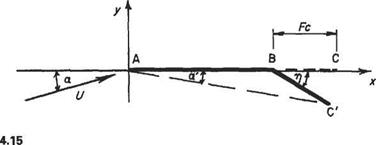The flapped aerofoil
Thin aerofoil theory lends itself very readily to aerofoils with variable camber such as flapped aerofoils. The distribution of circulation along the camber line for the general aerofoil has been found to consist of the sum of a component due to a flat plate at incidence and a component due to the camber-line shape. It is sufficient for the assumptions in the theory to consider the influence of a flap deflection as an addition to the two components above. Figure 4.14 shows how the three contributions can be combined. In fact the deflection of the flap about a hinge in the camber line effectively alters the camber so that the contribution due to flap deflection is the effect of an additional camber-line shape.
The problem is thus reduced to the general case of finding a distribution to fit a camber line made up of the chord of the aerofoil and the Пар chord deflected through rj (see Fig. 4.15). The thin aerofoil theory does not require that the leading and/or trailing edges be on the x axis, only that the surface slope is small and the displacement from the x axis is small.
With the camber defined as he the slope of the part AB of the aerofoil is zero, and that of the flap – h/F. To find the coefficients of к for the Пар camber, substitute these values of slope in Eqns (4.41) and (4.42) but with the limits of integration confined to the parts of the aerofoil over which the slopes occur. Thus
![]() (4.48)
(4.48)
where ф is the value of в at the hinge, i. e.
 |
(I – F)c = ^(1 – cos</>)
Fig. 4.14 Subdivision of lift contributions to total lift of cambered flapped aerofoil

whence cos ф — 2F — 1. Evaluating the integral
£
-к) F
i. e. since all angles are small h/F = tan 77 ~ 77, so
![]() ‘lo =
‘lo =
Similarly from Eqn (4.42)
i4„=-|y 0 cos n(?d(? + J —^cosn6d0|
Thus
 7Г 7Г
7Г 7Г
|
k = 2Ual +CO*d + 2U sin в |
The distribution of chordwise circulation due to flap deflection becomes
 |
|
and this for a constant incidence a is a linear function of 77, as is the lift coefficient, e. g. from Eqn (4.43)
Note that a positive flap deflection, i. e. a downwards deflection, decreases the moment coefficient, tending to pitch the main aerofoil nose down and vice versa.











